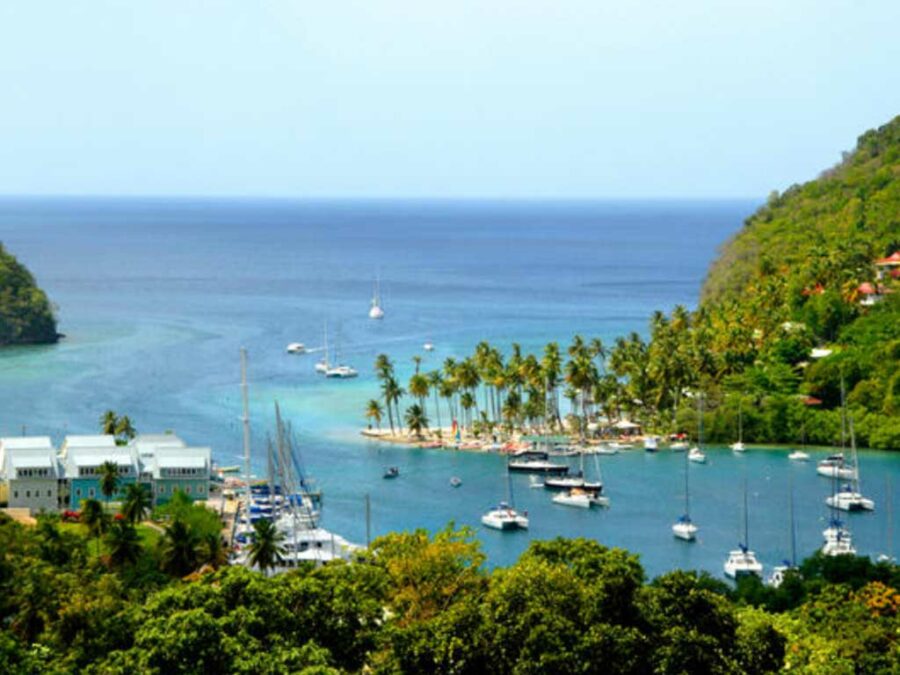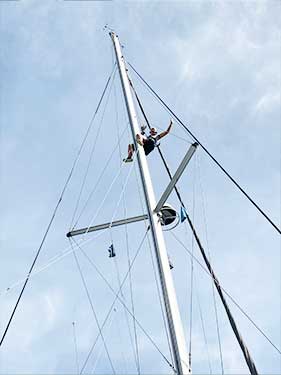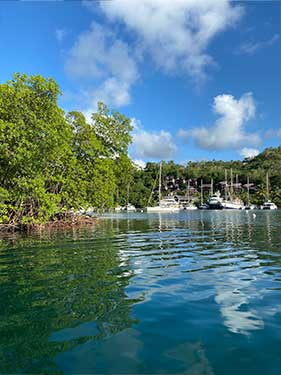Marigot Bay St Lucia
What to do in Hurricane Season? Where to put the boat? For the period from July to November, all owners staying in the Caribbean are looking for a solution for their vessel – so that it does not fall victim to a hurricane. Hurricanes of higher categories can easily destroy yachts completely, whether small or mega size. Moorings in sheltered locations are limited, so coveted and expensive.
Karin in the mast (the tiny lady on the very top)
The 2022 Hurricane Forecast
NOAA’s National Hurricane Center has forecast an above-average hurricane season this season again. 14-21 named storms are expected. Of these, 6-10 have hurricane potential. And out of that group, 3-6 hurricanes can become the super-dangerous category 3-5, with wind speeds of at least 111 mph.
NOAA has given a probability of 70% for this forecast. Or in other words: can be, but doesn’t have to be. But in case of heavy winds: the list of names of the storms is already fixed for the whole alphabet.
In the 2021 season, only one hurricane (Cat. 1), “Elsa”, made landfall in the eastern Caribbean. Without major damage. A boon for the recently plagued islands. 6 other hurricanes raged either near the US coast or on the Atlantic. According to meteorologists, the cause of this fortunate coincidence was the volcanic eruption in La Palma, which deflected the direction of the storms.
Hurrucanes and insurance
Insurance companies usually charge around 1.5 % of the vessels value just for the hurricane season, in addition to the usual 1.0 -1.5 % p.a. And they make up the rules. The most common is to keep the boat out of 13 and 33 degrees latitude. This is a belt between Grenada to the south and the Chesapeake Bay in the US to the north, also known as the “hurricane belt”. In addition, almost all insurance companies require a hurricane plan to be agreed to in order for the vessel to be covered.
Hurricane Holes
Some insurers allow exceptions, e.g. in recognised “hurricane holes”. These are places within the hurricane belt that have historically proven to be safe places. A few of these places have nevertheless been banged up pretty badly, e.g. Virgin Gorda’s North Sound in the BVI or Nelson’s Dockyard in Antigua.
What makes a hurricane hole? Such a place protects against the three main evils of a hurricane: extreme wind, extreme waves, extreme rain.
Our hurricane hole: Marigot Bay
After Grenada last year, we chose Marigot Bay in St Lucia for this off-season. It’s at 13.57 degrees north latitude, still just inside the Hurricane Belt, but it’s actually a Hurricane Hole with no history of damage. It has everything in perfection that a Hurricane Hole needs:
A bay surrounded by mountains, almost a small fjord. The surrounding mountains are several ship heights high and lie in several rows, which prevents downdrafts. In addition, the mountains are densely overgrown with forests. A perfect windbreak.
The bay opens west to the sea, but is protected by a headland. This means you have to slalom to reach the inner bay. No wave can crash directly into the bay. And then there’s the miracle cure for swell: mangroves. There are plenty of them here, too. There are studies that prove that mangroves reduce the swell by 2/3. In fact, the swell is low, the bay is usually as smooth as a lake. This mixture makes Marigot Bay a safe place (so far).
We decided early in the season not to sail further south and spend our hurricane season in Marigot Bay. The Rivercafe is moored on a wooden dock, just inside the mangroves. We have zero swell and are right in the green. We have the feeling that we will be well protected here even in the event of a hurricane. Time will tell.
And the crew?
After we return from Europe and the USA, we will spend another 2 months on board in St. Lucia, during the hot phase of the hurricane season. That is a very long time by our standards. Marigot is much smaller than Fort-Louis Marina in Grenada. Fort-Louis is packed with vessels from different countries, but mostly US-Americans. These guys usually stand in a small pool from the afternoon onwards, sipping their drinks and explaining the world before disappearing again into their air-conditioned boats.
There are far fewer people in Marigot and we hear no ac running. Everything is smaller. But we have 5 restaurants/bars/pubs within a 5-minute radius, all of which are very special. One with fantastic fish and a fabulous sea view, one in the middle of the mangroves with delicious crabs, one in front of the entrance with steaks on hot stone, a nice harbour resto and a fancy restaurant in the hotel. And this 5-star hotel with a big pool, fitness and spa – all facilities we can use.
Everything around us is green and at night the crickets and frogs chirp romantically. When we are back, the internet should also be really good and we will be able to work. Unfortunately, the place in the mangroves also provides plenty of mosquitoes, which torment us especially at night. On the other hand, we will have the relaxed Zen atmosphere of a very special piece of earth and, from September, plenty of time to get to know the island intensively.
It would be nice if all the islands of the Eastern Caribbean could experience another quiet hurricane season and be spared catastrophes. /Holger Binz











Mögen die Winde an Eurem Ankerplatz vorbeiziehen und die RC und Euch verschonen!
Happy relaxing !